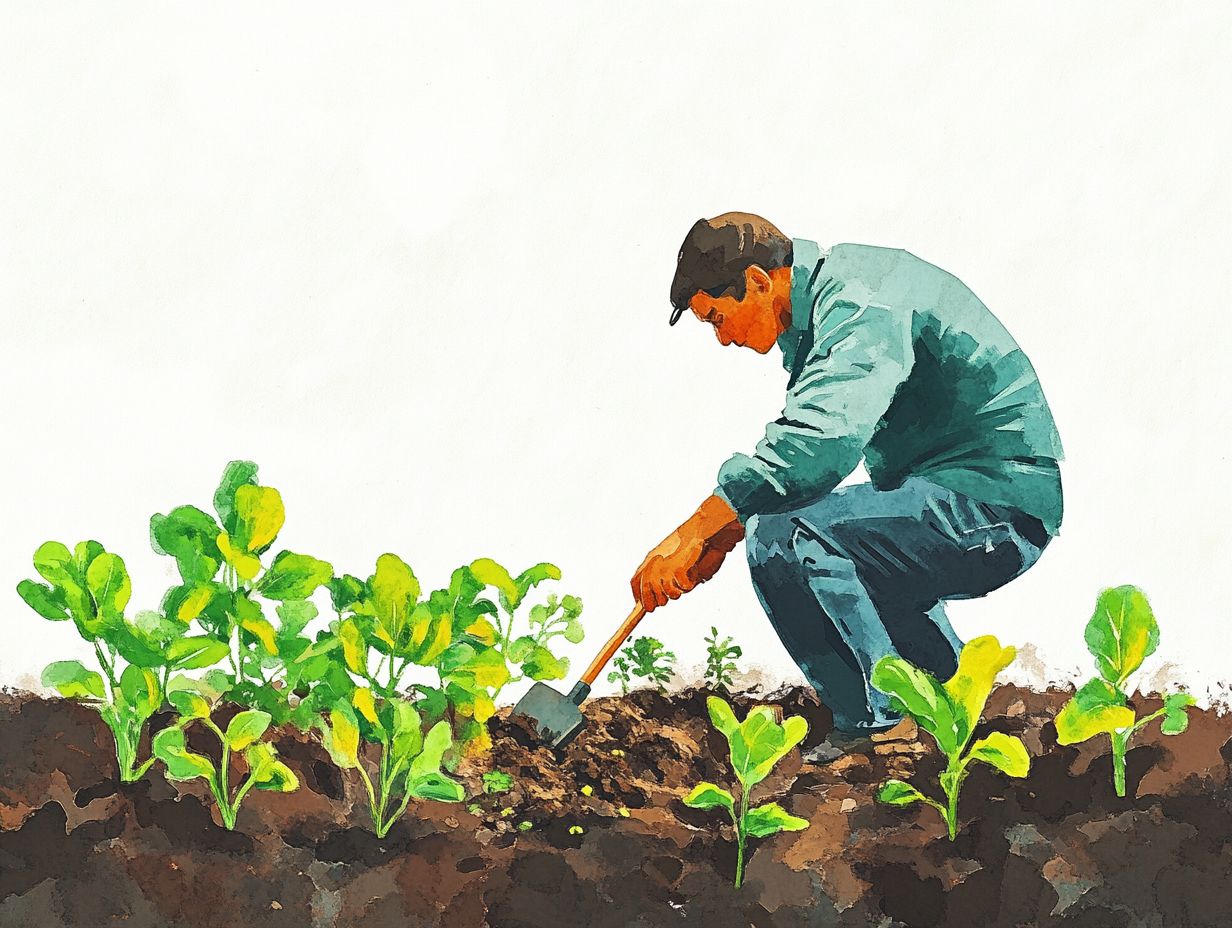Preparing Soil for Early Spring Planting
As winter recedes and the vibrant promise of spring dawns on the horizon, now is the perfect moment for you to prepare your garden soil!
Grasping the essentials of soil preparation is vital for cultivating a flourishing garden. It establishes the foundation for robust plants. From evaluating nutrient levels and pH to tasks such as clearing away debris and adding fertilizers, this guide will expertly lead you through every step of the process.
Prepare to nurture a nutrient-rich environment that guarantees your spring planting will be a resounding success!
Contents
- Key Takeaways:
- Understanding Soil Preparation for Early Spring Planting
- Assessing Your Soil
- Steps for Preparing Soil
- Timing for Soil Preparation
- Tips for Maintaining Healthy Soil
- Frequently Asked Questions
- What are the benefits of preparing soil for early spring planting?
- When is the best time to start preparing soil for early spring planting?
- What steps should I take to prepare my soil for early spring planting and ensure optimal soil preparation?
- Can I use chemical fertilizers to prepare my soil for early spring planting or should I consider organic nutrients?
- Do I need to prepare my soil every year for early spring planting?
- Are there any special considerations for preparing soil for early spring planting in raised beds or containers, including the use of low-till gardening and no-till gardening methods?
Key Takeaways:

- Properly preparing soil before planting is essential for healthy plant growth and a successful harvest.
- Conducting a soil test to assess nutrient levels and pH can help determine the necessary amendments and fertilizers to add.
- Removing debris and weeds, adding amendments and fertilizers, and mixing the soil are important steps in preparing for early spring planting.
Understanding Soil Preparation for Early Spring Planting
Understanding soil preparation is essential for successful spring planting. It plays a pivotal role in the health and yield of your crops. Proper preparation involves assessing the type of garden soil you have, adjusting its nutrient content, and creating an optimal environment for spring vegetables to thrive.
Whether you choose a method that disturbs the soil less or stick with traditional methods, the cornerstone of a productive garden rests on how effectively you prepare your soil to support new vegetable starts and transplant seedlings.
Importance of Preparing Soil
Preparing the soil is crucial for successful garden maintenance. It ensures that both nutrient content and pH levels are tailored for growing vibrant spring vegetables.
When you invest time in proper soil preparation, you enhance the overall health of your plants. This directly influences their growth potential and lays a solid foundation for effective weed control and boosts nutrient uptake.
You can utilize soil testing services to identify missing nutrients and employ tools like Luster Leaf s pH test kits. This proactive approach fosters strong plants and helps create a sustainable gardening environment where resources are used wisely.
Assessing Your Soil
Assessing your soil is an essential step. It requires a thorough soil test to determine the type of soil you have, its nutrient content, and pH levels. These factors are crucial for achieving a successful spring planting.
Testing for Nutrient Levels and pH
Testing the nutrient levels and pH in your soil is essential for determining the amendments needed. By evaluating these factors, you can make informed decisions about which nutrients are lacking.
Using soil testing kits, like those provided by Penn State, allows you to obtain precise measurements of vital elements such as nitrogen, phosphorus, and potassium. These nutrients are crucial for plant growth, influencing everything from root development to fruit production.
Once you have the results, they ll guide you in applying specific fertilizers or organic amendments. This ensures your soil is fine-tuned to meet the unique needs of your vegetables, promoting healthier plants and improved yields.
Steps for Preparing Soil

Preparing your soil is a meticulous process that encompasses several essential steps.
- Begin by clearing away any debris and weeds that could hinder growth.
- Incorporate the necessary soil amendments to enhance its quality.
- Ensure that the soil is thoroughly mixed and aerated, creating ideal conditions for growth.
Start your soil preparation today and watch your garden thrive this spring!
Removing Debris and Weeds
Removing debris and weeds is a crucial aspect of garden maintenance. It keeps the soil free from competition and pathogens, ultimately promoting the healthy growth of your spring vegetables.
When you let these unwanted plants take over, they can take away important nutrients and water. This puts your carefully nurtured veggies at a disadvantage. Some weeds even host pests or diseases that can easily spread to your thriving crops, putting their health at risk.
To tackle this issue effectively, make it a habit to regularly hand-pull weeds or utilize tools like a hoe to uproot them. Do this before they have a chance to flower and scatter seeds.
Incorporating compost into your gardening routine enriches the soil with organic matter and improves its structure. This results in better drainage and increased microbial activity. All of this contributes to the overall vitality of your plants, ensuring they flourish under your care.
Adding Amendments and Fertilizers
Adding amendments and fertilizers enriches your soil with essential organic nutrients. This sets the stage for a flourishing garden come spring.
Among the myriad options, compost and chicken manure truly shine as standout choices. Compost boosts the organic matter content, serving as a slow-release source of nutrients. Chicken manure packs a punch with its high nitrogen, phosphorus, and potassium content.
By integrating these amendments, you’ll elevate the soil’s nutrient levels. This cultivates an environment that encourages robust plant growth.
Nitrogen promotes leafy development, phosphorus supports strong roots and vibrant flowers, and potassium enhances overall plant vigor. Together, these amendments are essential in nurturing a thriving garden ecosystem.
Tilling or Turning the Soil
Tilling or turning the soil is a crucial step in preparing your garden. It enhances aeration and allows for the effective incorporation of soil amendments, whether you opt for low-till or no-till methods.
While traditional tilling may seem effective for immediate weed control and soil mixing, it can disrupt soil structure. This can lead to the erosion of essential nutrients over time. Many growers champion these conventional techniques, but don t miss out on the benefits of low or no-till practices.
These alternative methods promote better moisture retention and a healthier microbial ecosystem. By minimizing soil disturbance, you can significantly improve soil health. This encourages deeper root growth and increases biodiversity.
Embracing low or no-till strategies is not just a nod to modern gardening; it s a powerful step toward sustainable agricultural practices that foster long-term soil integrity and productivity.
Timing for Soil Preparation
The timing for soil preparation is crucial. Aligning your efforts with the planting calendar will create optimal conditions for early spring planting and set the stage for a successful crop establishment, especially when you follow guidelines such as preparing your planting beds for winter.
Best Time to Prepare Soil for Early Spring Planting

The ideal time to prepare your soil for early spring planting is typically between late winter and early spring. This timeframe provides you with ample opportunity to amend the soil, and following a guide to preparing soil for fall planting can help ensure your spring vegetables thrive.
During this essential period, focus on assessing your soil s drainage, pH levels, and nutrient content. As winter fades, the shifting weather conditions will dictate when the soil is ready to be worked. It s important that the ground is neither frozen nor excessively wet.
As you approach your planting calendar, particularly from mid-March to early April, tilling the soil and incorporating organic matter become crucial tasks. This proactive approach ensures that your soil is loose and nutrient-rich, primed to support a thriving vegetable garden when planting season kicks off.
Tips for Maintaining Healthy Soil
Maintaining healthy soil is an ongoing journey. It requires your dedicated attention to regular garden maintenance, the thoughtful addition of organic nutrients, and effective weed control.
By committing to these practices, you can ensure the longevity and productivity of your garden for years to come.
Start your garden prep today for a bountiful harvest!
Practices to Keep Soil Nutrient-Rich
To maintain nutrient-rich soil, incorporate practices like regular composting, adding organic nutrients such as chicken manure, and using effective weed control methods.
These strategies not only enhance soil fertility but also strengthen overall plant health and their resilience against diseases. Composting introduces beneficial microorganisms into your soil, which are essential in breaking down organic matter and releasing vital nutrients.
When applied correctly and in moderation, chicken manure a rich source of nitrogen can significantly promote plant growth.
Consider practical tips like ensuring a diverse compost mix that includes kitchen scraps and yard waste. Monitor nutrient levels through soil tests. Reputable resources like the USDA’s Natural Resources Conservation Service provide guides on sustainable soil management practices that can lead to healthier crops and better yields.
Frequently Asked Questions
What are the benefits of preparing soil for early spring planting?
Preparing soil for early spring planting creates an ideal environment for seed germination and plant growth, resulting in healthier and more productive plants. For those in colder areas, preparing your soil for spring in cold climates allows for better root development and nutrient absorption, giving plants a strong foundation for the growing season.
When is the best time to start preparing soil for early spring planting?

The best time to start preparing soil for early spring planting is a few weeks before the last frost date in your area. This timing allows you to properly amend and prepare the soil without risking damage from late freezes.
What steps should I take to prepare my soil for early spring planting and ensure optimal soil preparation?
First, remove any debris and weeds from the area. Then, loosen the soil with a garden fork or tiller. Add organic matter such as compost or aged manure to improve soil structure and fertility. Finally, test the soil’s pH this is a measure of how acidic or alkaline your soil is and adjust it if necessary.
Can I use chemical fertilizers to prepare my soil for early spring planting or should I consider organic nutrients?
While chemical fertilizers can provide quick nutrients, they may harm the environment and soil health in the long run. It s best to use organic fertilizers and amendments, as they are more sustainable and beneficial for the overall health of your plants and soil.
Do I need to prepare my soil every year for early spring planting?
Make it a habit to prepare your soil every year for thriving plants! This practice helps replenish nutrients depleted by repeated planting and harvesting. It also improves soil structure and creates a balanced environment for plants to flourish.
Are there any special considerations for preparing soil for early spring planting in raised beds or containers, including the use of low-till gardening and no-till gardening methods?
If you are planting in raised beds or containers, use a high-quality potting mix designed for container gardening. These mixes ensure proper drainage and nutrient balance for plants in confined spaces. Regularly amend the soil in raised beds and containers to maintain its fertility.
Low-till gardening means minimizing soil disturbance, while no-till gardening avoids tilling altogether. These methods help preserve soil structure and health.






